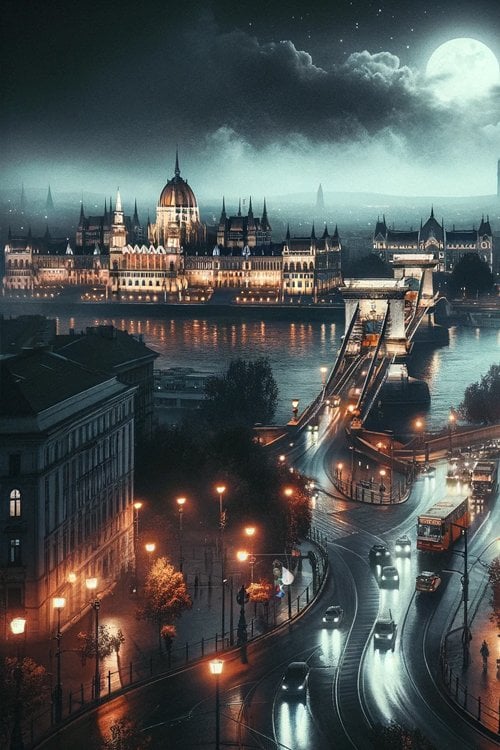András, a man in his thirties from Budapest who once spent years working as a club photographer, has distanced himself from the bustling music scene to focus on documentary work. Tasked with documenting a nighttime event by an old friend, he decides to dive back into the whirl of Budapest's nightlife. His project aims to illuminate the individuals and stories often hidden behind the city’s lights.
One evening, while walking past the Dunapark Café on the banks of the Danube, András contemplates the stories lurking beneath the surface. Many of his former acquaintances, including those working in the sex industry, are still part of the nightlife. Thus, he decides to use his camera to delve deeper into this world and communicate the importance of understanding and dismantling societal prejudices through their stories.
András begins to explore the city's hotspots where the nightlife is most intense. He visits areas around Nyugati Railway Station and Blaha Lujza Square, where he can often meet sex workers. He uses his old contacts to reconnect with those who can help him navigate this world. He attends nighttime events, visits places like "Szimpla Kert" and "Gozsdu Court," where he takes photos and engages in conversations.
Zoltán's Story
When I first decided to try my luck as a sex worker, I felt as if all stable ground had slipped from under my feet. I am a former security guard who spent years in the heart of Budapest's nightlife, along the Grand Boulevard. I knew the dangers of nightlife well, yet I didn’t anticipate how different it would be facing them myself. In the first few days, I frequently encountered familiar faces in the dark alleys of Deák Square and Kazinczy Street, where the night never ends. They were surprised to see me in this role, and I also struggled to accept my new reality. The people I once kept safe in the clubs now saw me differently. I quickly faced the dangers of my work: drugs, violence, and constant uncertainty. Each night was a new trial, and although the money came quickly, the guilt and self-doubt were heavier burdens than the physical risks. One night, after leaving a client’s apartment on József Boulevard, I encountered another sex worker who had just been assaulted. I had to help them, and that’s when I decided to do more: I started talking to other sex workers, and we shared our survival techniques. I initiated a group where we could support each other.
Levente's Story
As a transgender man, life has never been simple for me. When I left my small village in Pest County for Budapest, I hoped to find greater acceptance in the big city. However, life confronted me with unexpected hardships, and I soon realized that the doors of the hospitality industry were not open to me. I began to discover another side of nightlife around Astoria and Király Street. There, I first met others who walked in similar shoes. I started working with them, and I realized that although sex work comes with many dangers, it also offers an opportunity to be my own boss. Throughout my work, I faced numerous dangers, from physical assaults to emotional manipulation. But I learned that the night, which harbors so many threats, also offers opportunities for connections and self-expression. I often encountered the police, and I frequently felt that I had nowhere to turn. When András photographed me and captured my story, I realized I needed to show others: change is possible, and society needs to hear our voices.
Tamás's Story
I have been part of Budapest's nightlife for more than three decades. I started in the early '90s when everything was different. After the fall of socialism, opportunities suddenly opened up, and many, like myself, saw the future in new industries. From Váci Street to Nagymező Street, I’ve worked everywhere and seen how the lives of the city and its people have changed. Dangers have always been part of this job, from police raids to the everyday physical risks we face. But somehow, I always survived, and perhaps that gave me the courage to keep going. After meeting András, I felt it was time to let others see this world. I shared with him how the conditions of sex work had changed over the years and how our social perception had transformed. I hoped my story would help people understand better who we truly are, those of us who live in the night.
As the project neared completion, András felt something had changed within him. The many encounters and conversations he had with sex workers not only added depth to his series but also transformed his own worldview. He understood that the stories he collected were not just simple narratives; they reflected the real struggles and hopes of real people. This realization prompted him to present his project to a broader audience.
The Exhibition András organized a photo exhibition in a popular art gallery in the heart of Budapest, where he displayed not only his photos but also the stories associated with them. Each image was accompanied by a brief text that narrated the story, thoughts, and feelings of the person depicted. The exhibition was widely advertised, and many attended, including journalists, artists, students, and activists, as well as the sex workers who participated in the project.
Social Dialogue The exhibition sparked a social dialogue about the situation and rights of sex workers. Several articles appeared in local and national press highlighting the significance of András's work and the necessity for social change. Many exhibition visitors had never before considered the complexities of sex work and the related issues.
Community Impact The project and exhibition strengthened the cohesion of the sex worker community. Many felt for the first time that society was truly listening to their voices. Additionally, András's initiative prompted more civil organizations and legal advocacy groups to actively address the protection of sex workers' rights, potentially leading to further social debates and legal changes in the future.
Personal Change For András, this project opened a new chapter in his career and life. He realized that through his art, he could induce social changes and that photography was much more than taking pictures: it was a tool for understanding, empathy, and change. He resolved to continue addressing social issues through his art, working on further projects that could shine a light on the shadowed parts of society.
Sincerely,
Night Whisperer
Budapest, May 14, 2024.
"The Storyteller of the Dark Streets"






